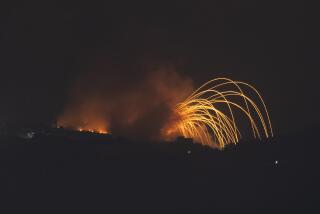From the archives: Swayed by Revolutionary Islam
WASHINGTON -- There are usually no more than a handful--ragtag bands of former shoe clerks or bakery workers, anonymous students or manual laborers in Lebanon’s orange groves. Often, they seem to have barely enough money to feed themselves and their families.
But they have guns. And they have one more thing: American hostages.
In the remorseless calculus of terrorism, that is all it takes to paralyze the power centers of the world.
As the Bush Administration is discovering, one of the things that makes terrorism and hostage-taking so hard to deal with is that many of the groups involved are so small and so narrowly based and operate in a netherworld so alien to the realm of superpower diplomacy.
“In any other context, these people would be absolute nobodies,” said a U.S. counterterrorism official. “Taking hostages is the only asset they have. But with hostages, they are world players.”
Intelligence analysts believe that all of the groups fall under the broad umbrella of the pro-Iranian Hezbollah, or the Party of God. And Administration officials expressed guarded hope Wednesday that behind-the-scenes pressure from Iran and Syria had at least temporarily lifted the death sentence imposed by his captors against American hostage Joseph J. Cicippio.
But the promise of respite--if it is granted for Cicippio--is temporary at best. The myriad groups that have abducted foreign nationals in Lebanon during the five-year hostage crisis have such distinct personalities, use such diverse tactics and pursue such individual agendas that even their chief supporters and benefactors--Iran and Syria--cannot fully control them.
Their grandiose names suggest the boldness and bravado of their tactics: the Revolutionary Justice Organization, the Organization of the Oppressed on Earth, and Islamic Jihad. Tiny as most are, each professes to be fighting the injustice and tyranny of the outside world.
The one thing almost all share is a common lineage, according to U.S. analysts. The Shiite Muslim youths who make up most of the captor groups are all products of the violence of Lebanon’s 14-year civil war and the systematic discrimination imposed on the Shiites by both the Maronite Christians and Sunni Muslims.
These factors make them highly vulnerable to the appeal of revolutionary Islam exported by Iran, experts say. But the catalyst for the emergence of Hezbollah was, ironically, Israel’s 1982 invasion of Lebanon.
“I believe that among the many surprises that came out of the war in Lebanon, the most dangerous is that the war let the Shiites out of the bottle,” conceded then-Israeli Defense Minister Yitzhak Rabin in 1985, shortly before Israel ended its three-year occupation of most of southern Lebanon under pressure from Shiite extremists.
“No one predicted it. I couldn’t find it in any intelligence report,” Rabin lamented. “In my opinion, the Shiites have the potential for the kind of terrorism that we have not yet experienced.”
In response to the invasion, Iran dispatched about 1,000 Revolutionary Guards to Lebanon, allegedly to help Lebanese Muslims and Palestinians fight Israel. Instead, the Iranians were missionaries more than soldiers, proselytizing the local population and recruiting men for new militias.
A Quiet Player
By 1983, Hezbollah had become a quiet player, spreading its tentacles into Muslim-dominated West Beirut and challenging the traditional militias as well as Western peacekeepers from the United States, France, Britain and Italy.
Islamic Jihad, which now holds American hostages Terry A. Anderson and Thomas Sutherland, was the first of the many cells under the Hezbollah umbrella to gain world attention. Beginning in 1983, it introduced the deadly new terrorist tactic of suicide bombings during two attacks on the U.S. Embassy in Beirut and two others on the U.S. Marine and French peacekeeping forces in Lebanon. More than 300 people were killed in those attacks.
“For all the attention gained, the suicide bomb turned out to be rather ineffective,” said a U.S. diplomat formerly based in Beirut. “The victims were buried and then often forgotten.
“The targets also diminished as foreign embassies introduced new security and the peacekeepers went underground, then left. To achieve their goals, these groups had to look for something else.”
In the Western hostage, they found it.
On Feb. 10, 1984, Islamic Jihad abducted Frank Regier, an engineering professor, off the streets of Beirut. Since then, more than 130 foreigners from at least 18 nations have been seized in Lebanon by a dozen different cells, most but not all made up of pro-Iranian Shiite extremists.
“Like earlier terrorism tactics that proved effective--hijackings and car bombings--other groups then adopted the practice of kidnaping individuals off the street,” said the former Beirut envoy.
“After all, it is so easy. And you don’t need sophisticated weapons or access to intelligence to pull it off. Hostage-taking has now become the most effective terrorism tactic of the 1980s.”
The groups under the Hezbollah umbrella proliferated in part because of different motives, and because of ties of blood, clan and friendship, which exert a power in Middle East politics that Westerners often underestimate.
The Organization of the Oppressed on Earth, which claimed to have executed Lt. Col. William R. Higgins on Monday, was first heard of in 1986 after the abduction of several Lebanese Jews, four of whom the group claimed to have executed in retaliation for Israeli strikes on southern Lebanon.
The group gained international attention in 1987 after the seizure of two German businessmen in response to West Germany’s arrest of Mohammed Ali Hamadi. Hamadi was convicted this year of the 1985 hijacking of TWA Flight 847, during which an American sailor, Robert Dean Stethem, was killed and 39 other Americans were taken off the plane and held hostage in Beirut for 17 days.
The Organization of the Oppressed on Earth at the time was controlled by one of Hamadi’s brothers. He was also known to be a Hezbollah security official, according to U.S. intelligence. The group’s members are believed to be mainly friends who grew up together in the Shiite slums, which makes them so tightly knit that their group is impenetrable by outsiders or even other Lebanese.
And time may be on the captors’ side.
Islamic Jihad has held Anderson and Sutherland for more than four years in an effort to gain release of 17 Lebanese and Iraqi prisoners held in Kuwait for a series of 1983 bombings. Again the blood links emerge as a motive: One of the prisoners is the cousin and brother-in-law of Islamic Jihad’s leader, Imad Mughniyah.
Although the Reagan Administration was able to win release of three Americans during the 1985-86 arms-for-hostages swap with Iran, U.S. analysts say that they believe Tehran ran into problems in winning freedom for the last two Americans because of Mughniyah’s insistence on first freeing his relative.
Blood ties were also evident in the 1984 abduction of the Spanish ambassador to Lebanon and the 1985 kidnaping of the Swiss ambassador. In both cases the unnamed groups demanded the release of prisoners arrested in Spain and Switzerland. When compromises were worked out, the men were freed and the groups disappeared.
Holding American Writer
How the groups may be linked is reflected by the Revolutionary Justice Organization, which has threatened to kill hostage Cicippio. It also holds American writer Edward A. Tracy and is thought to have abducted British hostage negotiator Terry Waite.
French hostages released last year reported being held in the same facility as Islamic Jihad captives Anderson and Sutherland. U.S. intelligence believes that the two groups may have some common members or, at minimum, common jailers.
Although the captors usually hide behind ski masks or kaffiyehs, the Arab headdress, and hostages are often required to wear blindfolds, freed hostages have provided a picture of their jailers.
They range in age from late teens to early 30s. In discussions with hostages, several have talked of their political alienation and their deep religious beliefs. They have spoken adoringly of the late Ayatollah Ruhollah Khomeini of Iran and expressed hope that Lebanon would one day become an Islamic republic.
The depth to which the militias have penetrated Lebanese society also is reflected in their complaints that they have no employment alternative. They say that their work places have been destroyed by the war or their school days cut short by it.
Although most appeared to have limited educations, one told then-hostage Benjamin C. Weir that he had been a college physics student hoping for a scholarship to study in the United States until the Lebanese program ran out of money.
In contrast to the technological wizardry available to the Americans now trying to mediate an end to the hostage crisis, the captor groups appear to have limited resources. They operate largely out of the shanties and small apartment blocks in the Shiite slums where the hostages also are held.
Their most sophisticated equipment appears to be a video camera to tape threats and pictures of the hostages--and on two occasions grisly footage of their hanged victims. In 1986 the Revolutionary Organization of Socialist Muslims released a videotape allegedly showing hanged British hostage Alec Collett, although the tape was too grainy for British forensic experts to verify.
But the hostage-takers don’t need much more. Hostage-taking, “besides being the most effective terrorism tactic of the 1980s,” is also the most cost-efficient.
More to Read
Sign up for Essential California
The most important California stories and recommendations in your inbox every morning.
You may occasionally receive promotional content from the Los Angeles Times.










